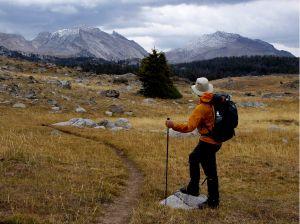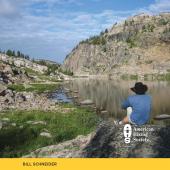Lightening the Load in Bozeman
Ultralight Backpacking—the latest trend in backcountry travel—has definitely found a home in Bozeman. In fact, though most locals might not know it, many people around the country see Bozeman as a kind of ground zero for the ultralight backpacking movement.
It all started back in 1987 when an eccentric and opinionated ex-climber, making his way north along the Pacific Crest Trail, decided that most backpacking experts didn’t know what the hell they were talking about. He’d been struggling along the PCT for weeks, burdened by the usual array of backcountry “necessities,” when it occurred to him that maybe life on the trail didn’t have to be so grueling. As he continued to make his way north, he started ditching gear that was proving inessential. By the time he reached Canada, his load had atrophied to a mere fraction of what he started with, and this quirky soul had firmly seized hold of a new vision of what backpacking ought to look like.
That born-again hiker was Ray Jardine, and the fruit of his vision has been a groundswell of interest in ultralight backpacking. By the end of his third major through-hike, Jardine had reduced his base pack weight (the amount he carried, less food and water) for a two-thousand-mile journey to a mere eight and a half pounds. With the publication of Beyond Backpacking: Ray Jardine’s Guide To Lightweight Hiking in 1999, Jardine codified his approach to ultralight backpacking and presented it to a broad audience for the first time. He also set off a maelstrom of controversy.
Critics have decried the ultralight approach as irresponsible and likely to induce novitiates to head into the wilderness unprepared and under-equipped. Meanwhile, droves of converts have enthusiastically embraced the ultralight philosophy and have, in fact, coalesced into a burgeoning “movement” within the backpacking world. A quick web search on “lightweight backpacking” will reveal a host of chat rooms, discussion groups, and web pages dedicated to the subject (my own search produced 384,000 links). One can find every imaginable facet of lightweight philosophy discussed, debated, and cogitated over in excruciating detail. These folks, it turns out, tend to spend a lot of time thinking about how to lighten their loads.
For a while it was pretty easy to ignore this eccentric and exacting subculture. After all, they seemed insistent on taking this whole lightweight thing to absurd extremes, and their ranks seemed inordinately populated with engineers—a sure sign that the whole bunch was wound just a little too tightly. Indeed, until fairly recently, the ultralight backpacking crowd had consisted of a small band of obsessives lurking about the fringes of the conventional backpacking world, tinkering with homemade alcohol stoves constructed out of soda cans, and paying ungodly amounts of money for titanium cooking paraphernalia.
Things have changed. The ultralight approach isn’t just for the fringe element anymore. A survey of the catalogues from virtually any of the big, established gear manufacturers reveals a host of lightweight offerings. You name it and you can probably find an ultralight version: stoves weighing just a few ounces, sub-two-pound packs, one-and-a-half pound sleeping bags, 24-ounce tents, four-ounce wind shirts; the list is endless.
And while the ultralight movement has apparently been gaining momentum virtually everywhere there are backpackers, it’s taken a particularly strong hold in Bozeman. Located less than a mile apart, on the north side of town, is a pair of quiet, unassuming businesses that have become key players in the world of lightweight backpacking.
At about the same time Ray Jardine was refining his approach to long-distance hiking on the nation’s three übertrails, a handful of alpinists in the Pacific Northwest were experimenting with reducing the loads they carried on their forays into the Olympics and Cascades. They found that carrying less weight resulted in increased range, less fatigue, and more flexibility. Bozeman resident Ryan Jordan was among this group of alpinists, and for him, those early experiments have resulted in a career path.
Jordan is the founder and editor of BackpackingLight.com, an online magazine dedicated exclusively to lightweight and ultralight backpacking. When Jordan moved to Bozeman in 1995, he effectively brought the ultralight movement to Montana. Launched in 2000, BackpackingLight.com has emerged as perhaps the most authoritative source for information on ultralight backpacking in the field. The magazine’s emphasis, in addition to providing in-depth equipment reviews of the latest and lightest gear, is on creating a repository of instructional material for those interested in going light. Jordan and his band of ardent gearheads have developed a reputation for cutting through marketing hype and providing sound and unbiased feedback on the profusion of new gear released each year.
And if BackpackingLight.com is leading the charge in providing information and content to ultralight practitioners around the world, then ProLite Gear, a Bozeman-based retailer located less than a mile from Jordan’s office, is working to outfit them. Specializing only in lightweight and ultralight backcountry pursuits, ProLite Gear opened in December 2003, and since that time has been providing gear to local customers in a modest retail space at 707 Bridger Drive. In addition to the brick-and-mortar storefront, ProLite Gear also has a substantial web presence. Every week they ship orders to customers in a variety of countries including New Zealand, Japan, England, Russia, and Brazil; they also serve a growing number of customers all over the United States and Canada.
In addition to focusing exclusively on lightweight gear, ProLite has set itself apart by building relationships with a host of small, cottage-industry manufacturers. As a result, one can go to ProLite and find a variety of products that tend to define the cutting edge in approaches to lightweight design, but are not readily available in conventional outdoor shops. ProLite owner Craig Delger says that most retailers don’t seek out cottage-industry manufacturers because they don’t typically appeal to the mass market, but that he likes working with the small guys. “The smaller manufacturers obviously don’t have the name recognition of the bigger companies, but they’re often rich sources of innovation for the lightweight community, and a lot of our customers really like to stay at the cutting edge.”
Because the lightweight crowd still only makes up a fraction of the total backpacking population, the customer base is still fairly diffuse, and as a result the ultralight niche is particularly well-served by a web-based retail approach. Delger reports that many customers both here and abroad have been extraordinarily enthusiastic about the shop. “Most places carry some lightweight gear, while still emphasizing the heavier conventional stuff. Our approach is a little different. The idea is to give people who are serious about lightweight backpacking a place where every piece of gear they come across fits comfortably within the lightweight category.” So far, the approach has been paying off. Since opening, ProLite Gear has experienced dramatic growth, and has established itself as one of the nation’s best sources of equipment for lightweight mountain sports.
According to Ryan Jordan, lightweight practitioners now constitute about 10 percent of the total backpacking population. At this point, it’s unclear whether the lightweight movement simply represents the latest trend in backpacking, or is indicative of a more significant and far-reaching shift in the way people are starting to think about traveling in the backcountry. What does seem clear is that the lightweight approach has been gaining momentum over the last couple of years and shows no signs of fading any time soon. And given the local resources, it also seems likely that regardless of how this trend plays out, those of us in Bozeman will have front-row seats.












